New Approach for Solving a Class of Doubly Singular Two-Point Boundary Value Problems Using Adomian Decomposition Method
Abstract
We propose two new modified recursive schemes for solving a class of doubly singular two-point boundary value problems. These schemes are based on Adomian decomposition method (ADM) and new proposed integral operators. We use all the boundary conditions to derive an integral equation before establishing the recursive schemes for the solution components. Thus we develop recursive schemes without any undetermined coefficients while computing successive solution components, whereas several previous recursive schemes have done so. This modification also avoids solving a sequence of nonlinear algebraic or transcendental equations for the undetermined coefficients with multiple roots, which is required to complete calculation of the solution by several earlier modified recursion schemes using the ADM. The approximate solution is computed in the form of series with easily calculable components. The effectiveness of the proposed approach is tested by considering four examples and results are compared with previous known results.
1. Introduction
Type 1. Dirichlet boundary conditions: y(0) = a1, y(1) = c1
-
(E1) p ∈ C[0,1], p ∈ C1(0,1] with p > 0 in (0,1] and 1/p ∈ L1(0,1);
-
(E2) q > 0 in (0,1] and ;
-
(E3) (i) f ∈ C([0,1] × ℝ); (ii) ∂f/∂y exists and continuous, ∂f/∂y ≥ 0 for all 0 ≤ t ≤ 1 and all real y.
Type 2. Mixed type boundary conditions: y′(0) = 0, ay(1) + by′(1) = c
-
p ∈ C[0,1], p ∈ C1(0,1] with p > 0 in (0,1];
-
q > 0 in (0,1], q ∈ L1(0,1) and ;
-
the same as (E3).
In recent years, the study of such singular boundary value problems (1.1) has attracted the attention of several researchers [2–9]. In particular, if p(t) = 1, q(t) = t−1/2 and f(t, y) = y3/2 problem (1.1) with Type 1 boundary conditions is known as Thomas-Fermi equation. Thomas [10] and Fermi [11] independently derived a boundary value problem for determining the electrical potential in an atom. The analysis leads to the nonlinear SBVP y′′ = t−1/2y3/2 with boundary conditions given by y(0) = 1, y(b1) = 0.
Chan and Hon [12] considered the generalized Thomas-Fermi equation: , y(0) = 1, y(a) = 0 with , where 0 ≤ b2 < 1, c > 0, d2 > −2, e > 1, which is doubly singular problem. Problem (1.1) with q(t) = p(t) = tα where α = 2 arises in the study of the distribution of heat sources in the human head [13] with f(t, y) = −δe−θy, θ > 0, δ > 0.
There is a huge literature available on numerical methods for problem (1.1) with q(t) = 1, but very few numerical methods are available to tackle doubly singular boundary value problems. Reddien [14] studied the linear form of problem (1.1) and derived numerical methods for q(t) ∈ L2[0,1] which is stronger assumption than ().
Chawla and Shivakumar [15] established the existence as well as uniqueness of solution for problem (1.1) where q(t) = p(t) = tα. The existence and uniqueness for problem (1.1) have also been discussed by Dunninger and Kurtz [16] and Bobisud [1]. Later Pandey and Verma [17] extended the results on the existence uniqueness for problem (1.1) with Types 1 and 2 boundary conditions.
1.1. Adomian Decomposition Method (ADM)
In this subsection, we briefly describe standard ADM for nonlinear second-order equation.
The ADM has been used to solve nonlinear boundary value problems (BVPs) for ordinary differential equations by several researchers [4, 20–26]. Solving nonlinear BVP by standard ADM is always a computationally involved task as it requires the computation of undetermined coefficients y′(0) in (1.9) in a sequence of nonlinear equations which increases computational complexity.
It is important to note that the standard ADM (1.9) can not be applied directly to solve two-point boundary value problem (1.1) as the component y0 in scheme (1.9) is not independent from undetermined coefficient. Many researchers [23–25] have proposed modified ADM to overcome the difficulty by setting undermined coefficient y′(0) = c, and then it will be determined by using second boundary condition satisfying ψn(1) = y(1). In this case, it requires additional computational work to solve nonlinear equation ψn(1) = y(1) for c and c may not be uniquely determined.
In order to avoid solving such nonlinear algebraic equations for a two-point boundary value problems, Jang [26] introduced extended ADM for nonsingular problems with Dirichlet boundary condition. Khuri and Sayfy [27] applied a novel approach based on the mixed decomposition spline for solving singular problems arising in physiology. The method proposed by Ebaid [4] is based on the modification of Lesnic’s work [28]. Later, Duan and Rach [29] introduced special modified inverse linear integral operators for higher order boundary value problem.
To the best of our knowledge, no one has applied ADM to solve a class of doubly singular two-point boundary value problem (1.1) with Types 1 and 2 boundary conditions.
In this work, a new approach based on ADM and new integral operator are proposed for solving doubly singular two-point boundary value problems (1.1) with Types 1 and 2. To set up the modified scheme, we first consider DSBVP (1.1) and use all the boundary conditions and Adomian decomposition method to establish the recursion scheme. Thus a modified recursion scheme is developed which does not require the computation of undermined coefficients, whereas most of previous recursive schemes do require the computation of undermined coefficients (see [23–25]). In fact, the proposed recursion scheme is useful for solving problem (1.1) whether they are linear or nonlinear singular (nonsingular). The main advantage of the method is that it provides a direct scheme for solving the singular boundary value problem, that is, without linearization and discretization. Numerical results are presented to demonstrate the effectiveness of proposed recursive scheme. The symbolic and numerical computations have been performed using “MATHEMATICA” software.
The organization of the paper is as follows. Section 2 presents the inverse integral operator with modified Adomian decomposition method for doubly singular boundary value problems of (1.1) with Types 1 and 2 boundary conditions. In Section 3, the convergence of the method is discussed. In Section 4, we illustrate our method with numerical results along with graphical representation.
2. Modified Adomian Decomposition Method
In this section, we establish two modified recursive schemes for solving doubly singular boundary value problems (1.1) with Types 1 and 2 boundary conditions.
3. Convergence of Method
In this section, we discuss the convergence analysis of modified ADM for doubly singular boundary value problem (1.1).
Many authors [30–33] established the convergence of ADM for differential and integral equations. The first proof of convergence of ADM for the general functional equation was given by Cherruault [31]. Cherruault and Adomian [32] proposed a new convergence proof of Adomian decomposition method for the general nonlinear functional equation based on the properties of convergent series. Recently, Hosseini and Nasabzadeh [33] introduced a simple technique to determine the rate of convergence of ADM for initial value problem.
Theorem 3.1. Let M(y) be the nonlinear operator defined by (3.3) or (3.5) which satisfies the Lipschitz condition ∥M(φ) − M(ξ)∥≤δ∥φ − ξ∥, for all φ, ξ ∈ C[0,1] with Lipschitz constant δ, 0 ≤ δ < 1. If ∥y0∥<∞, then there holds ∥yk+1∥≤δ∥yk∥, for all k ∈ ℕ ∪ {0} and the sequence {ψn} defined by (3.10) converges to .
Proof. Since
We now show that the sequence {ψn} is convergent. To prove this, it is sufficient to show that {ψn} is cauchy sequence in Banach space C[0,1]. Now using the nonlinearity of M(y), we have
4. Numerical Examples and Discussion
In this section, we consider four examples to demonstrate the effectiveness of proposed recursive schemes (2.15) and (2.27). The numerical results are compared with known results and maximum absolute error is also calculated. We also plot approximate and exact solutions to show how approximate solutions converge to exact solution.
Example 4.1. Consider linear two-point boundary value problem [6]
| α | |||
|---|---|---|---|
| 0.25 | 2.3211 × 10−3 | 4.2210 × 10−5 | 2.4843 × 10−6 |
| 0.5 | 2.3151 × 10−3 | 6.1226 × 10−5 | 3.2320 × 10−6 |
| 0.75 | 3.5315 × 10−3 | 7.0126 × 10−5 | 2.2117 × 10−6 |
| α | |||
|---|---|---|---|
| 0.25 | 2.2419 × 10−3 | 3.3304 × 10−5 | 3.5127 × 10−6 |
| 0.5 | 1.3307 × 10−3 | 5.0264 × 10−5 | 4.6572 × 10−6 |
| 0.75 | 4.2104 × 10−3 | 4.3231 × 10−5 | 2.1260 × 10−6 |
| Proposed method | Chawla and Katti [6] | ||
|---|---|---|---|
| α, β | N | error | |
| α = 0.50, β = 4.0 | 2.4003 × 10−6 | 128 | 1.80 × 10−4 |
| α = 0.75, β = 3.75 | 5.1431 × 10−6 | 128 | 1.80 × 10−4 |
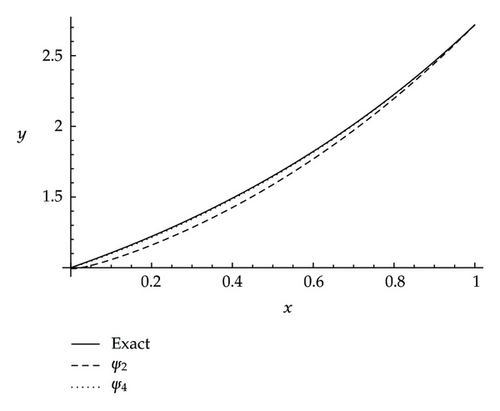
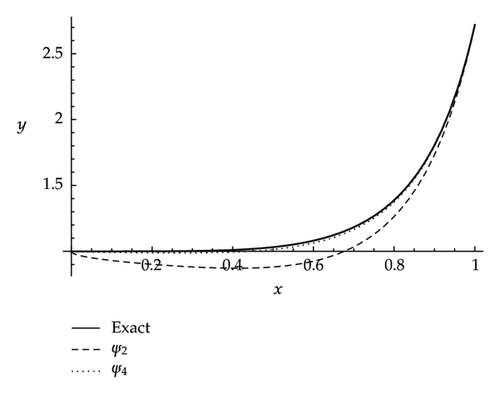
Example 4.2. Consider nonlinear singular two-point boundary value problem
If α = 0.25, β = 1, that is, p(t) = t0.25, q(t) = t−0.75, then problem (4.5) is called doubly singular boundary value problem.
| α | |||
|---|---|---|---|
| 0.25 | 1.3889 × 10−4 | 2.0435 × 10−6 | 2.5693 × 10−8 |
| 0.5 | 5.2987 × 10−4 | 1.1481 × 10−6 | 1.1616 × 10−8 |
| 0.75 | 2.4545 × 10−4 | 3.7571 × 10−7 | 2.1654 × 10−9 |
| α | |||
|---|---|---|---|
| 0.25 | 6.5109 × 10−4 | 2.6137 × 10−7 | 6.0161 × 10−8 |
| 0.5 | 8.8947 × 10−4 | 1.1610 × 10−6 | 7.1746 × 10−8 |
| 0.75 | 7.6596 × 10−4 | 5.2644 × 10−7 | 6.3210 × 10−8 |
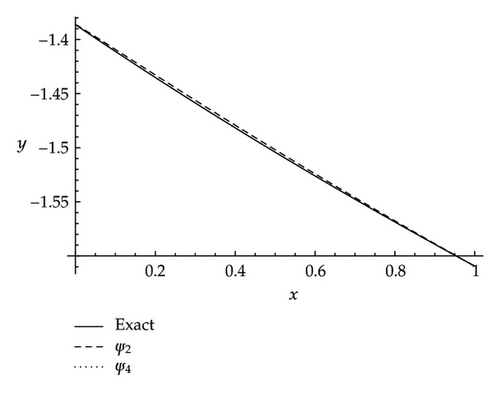
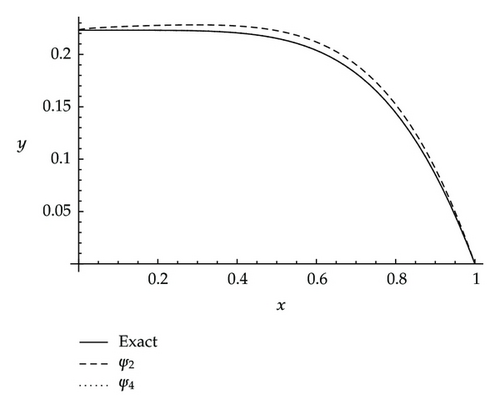
Example 4.3. The heat conduction model in human head problem Duggan and Goodman [13] is
| t | ψ6 | ψ8 | ψ10 | Solution in [13] |
|---|---|---|---|---|
| 0 | 0.27073627 | 0.27025895 | 0.27010891 | 0.27035006 |
| 0.2 | 0.26561546 | 0.26515412 | 0.26500927 | 0.26525434 |
| 0.4 | 0.25016332 | 0.24974709 | 0.24961677 | 0.24986712 |
| 0.6 | 0.22410365 | 0.22375398 | 0.22364491 | 0.22388597 |
| 0.8 | 0.18695255 | 0.18668071 | 0.18659620 | 0.18679895 |
| 1 | 0.13798246 | 0.13778979 | 0.13772998 | 0.13787263 |
Example 4.4. The nonlinear singular boundary problem considered by Chawla et al. [34] is
| n | n | Error in [34] | |
|---|---|---|---|
| 5 | 6.2129 × 10−4 | 16 | 2.52 × 10−3 |
| 8 | 1.0919 × 10−5 | 32 | 1.83 × 10−4 |
| 10 | 3.0638 × 10−6 | 64 | 1.28 × 10−5 |
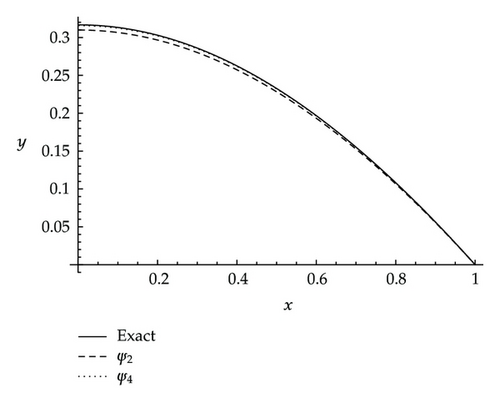
5. Conclusion
In this paper, we we have illustrated how the modified recursive schemes (2.15) and (2.27) can be used to solve a class of doubly singular two-point boundary value problems (1.1) with Types 1 and 2 boundary conditions. The accuracy of the numerical results indicates that the method is well suited for the solution of this type problem. The main advantage of this approach is that it provides a direct scheme to obtain approximate solutions, and we have also shown graphically that these approximate solutions are almost identical to the analytic solution. Another advantage of a modified recursion scheme is that this does not require the computation of undermined coefficients, whereas most of previous recursive schemes do require the computation of undermined coefficients (see [23–25]). The method provides a reliable technique which requires less work compared to the traditional techniques such as finite difference method, Cubic spline method, and standard ADM. The numerical results of the examples are presented and only a few terms are required to obtain accurate solutions. By comparing the results with other existing methods, it has been proved that proposed modified ADM is a more powerful method for solving the singular problems (1.1).




